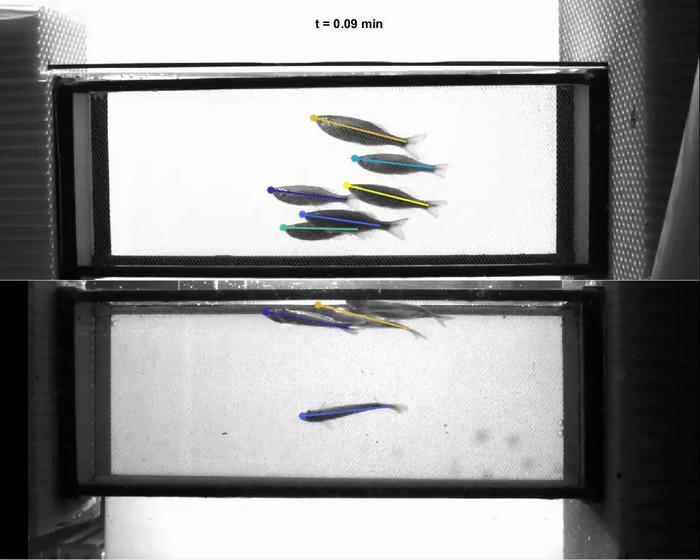
For over half a century, the scientific consensus held that fish schools achieve optimal energy efficiency by swimming in flat, diamond-shaped formations. This assumption, deeply rooted in both theoretical models and experimental observations, was largely based on two-dimensional perspectives of fish behavior. However, recent research conducted jointly by Princeton and Harvard scientists is challenging long-standing ideas, revealing a far more complex and three-dimensional pattern of movement within fish schools.
The study, spearheaded by Radhika Nagpal, a renowned professor of robotics at Princeton University, introduced novel computer vision methodologies to capture and analyze the 3D dynamics of schooling fish. By adapting software originally designed for tracking individual animal movements into a system capable of reconstructing three-dimensional trajectories, the team achieved unprecedented insight into the spatial arrangements beneath the surface of synchronized swimming groups.
The subject of their investigation was the giant danio, a species frequently used in biological experiments due to its manageable size and social swimming behaviors. Over a ten-hour period, six giant danios were tracked as they navigated a tank equipped with a recirculating flow system, mimicking natural aquatic conditions that influence swimming energetics. Contrary to prevailing expectations, the fish demonstrated an overwhelming preference for a “ladder” formation—staggered and layered across three spatial dimensions—nearly 80 percent of the time. The classic diamond formation was observed rarely, if at all.
.adsslot_ec2kXFVuvx{width:728px !important;height:90px !important;}
@media(max-width:1199px){ .adsslot_ec2kXFVuvx{width:468px !important;height:60px !important;}
}
@media(max-width:767px){ .adsslot_ec2kXFVuvx{width:320px !important;height:50px !important;}
}
ADVERTISEMENT
This ladder pattern can be likened to the arrangement of fighter jets flying in formation: individual fish occupy positions slightly offset vertically and horizontally from their neighbors rather than tightly arrayed on a flat plane. Such spatial distribution permits each fish to avoid the direct turbulent wake of the individual ahead, which typically reduces swimming efficiency due to resistive drag forces and energy expenditures.
Lead author Hungtang Ko, a postdoctoral researcher at Princeton, explains that swimming fish eject water jets backward akin to jet engines on airplanes. Traditional diamond formations, thought to minimize hydrodynamic drag by capitalizing on vortex structures, demand precise synchronization as fish align themselves in a single plane. The ladder formation, by staggering in multiple planes, reduces the burden of tight coordination while still delivering comparable energetic advantages. This dynamic three-dimensional spacing mitigates wake interference, allowing individual fish to exploit fluid dynamics more flexibly.
Early models revolving around two-dimensional formations originated in the 1970s and gained traction due to limitations in observational technology capable only of capturing flat, planar movement. These models contributed heavily to the conceptual understanding of animal locomotion and collective behavior but did not fully capture the intricacies of schooling fish movement. One core difficulty was obtaining accurate multi-angle camera data to analyze schooling behavior in three dimensions—an obstacle surmounted by the innovative computer vision approach applied in this current research.
The significance of this breakthrough spans beyond theoretical biology. The three-dimensional mapping of fish schooling opens novel avenues for robotic engineering, particularly in the field of underwater robotics. The Nagpal laboratory is actively exploring how fish-inspired robot swarms could mimic these ladder formations to achieve enhanced maneuverability and energy efficiency. With underwater robots becoming essential tools for monitoring delicate marine ecosystems such as coral reefs and kelp forests, biological insights into natural schooling can directly inform the design principles of future robotic swarms.
Moreover, understanding the physics of fish locomotion at a collective level provides critical data for computational fluid dynamics and bio-inspired propulsion designs. The complex hydrodynamic interactions revealed by the ladder formations highlight the need to incorporate multi-dimensional spacing in simulation models and robotic algorithms. This research exemplifies the increasingly interdisciplinary nexus of biology, robotics, and computer vision.
The collaborative nature of this research, including cooperation between biologists and roboticists, enriched both domains: biologists gained unprecedented visualization and quantification tools, while engineers obtained novel templates rooted in evolutionary optimization. As Ko states, the alliance is mutually reinforcing—computer vision reveals why animal groups adopt certain formations, and these biological insights guide the development of robotic systems that operate more naturally and efficiently in the real world.
By leveraging postdoctoral fellowships and grants such as those from the Office of Naval Research and the James S. McDonnell Foundation, the team capitalized on sustained funding support to push the frontiers of knowledge in dynamic multi-scale systems. The adaptation of techniques typically difficult to apply in aquatic behavioral studies signals a new era for ethology—one where 3D tracking tools can redefine our understanding of animal movement ecology.
Future research could expand the sample size and species diversity to determine whether ladder formations are a generalizable phenomenon across other fish taxa or dependent on specific ecological or evolutionary factors. Moreover, exploring the neurobiological underpinnings that enable fish to coordinate such complex multi-dimensional spatial arrangements represents another frontier spanning behavioral ecology and neuroscience.
This groundbreaking study, published in the June 27, 2025 issue of Scientific Reports, underscores the transformative power of technological innovation in revealing nature’s subtleties. It challenges dogma, reshapes conventional wisdom, and paves the way for bio-inspired engineering with far-reaching implications, from underwater robotics to conservation science.
The integration of 3D computer vision and hydrodynamic theory continues to unlock mysteries of collective animal behavior, proving that nature’s designs often surpass human-made models in both complexity and efficiency. In the dynamic world beneath water surfaces, fish schools don’t swim flat—they rise and fall, advance and stagger in an elegant three-dimensional ladder, exemplifying a sophisticated balance between energetic economy and behavioral flexibility.
Subject of Research: Animals
Article Title: Beyond planar: fish schools adopt ladder formations in 3D
News Publication Date: 27-Jun-2025
Web References: 10.1038/s41598-025-06150-2
References: Ko et al., “Beyond planar: fish schools adopt ladder formations in 3D,” Scientific Reports, June 27, 2025
Image Credits: Ko et al.
Keywords: Ethology, Robotics, Swarm robotics, Animal locomotion, Fish
Tags: aquatic social behaviorschallenges to scientific consensuscomputer vision in biologyenergy efficiency in schooling fishfish school dynamicsfish swimming formationsgiant danio behavior studynovel research in fish schoolingPrinceton Harvard collaborationrobotics in animal behaviorspatial arrangements in fish schoolsthree-dimensional fish movement



